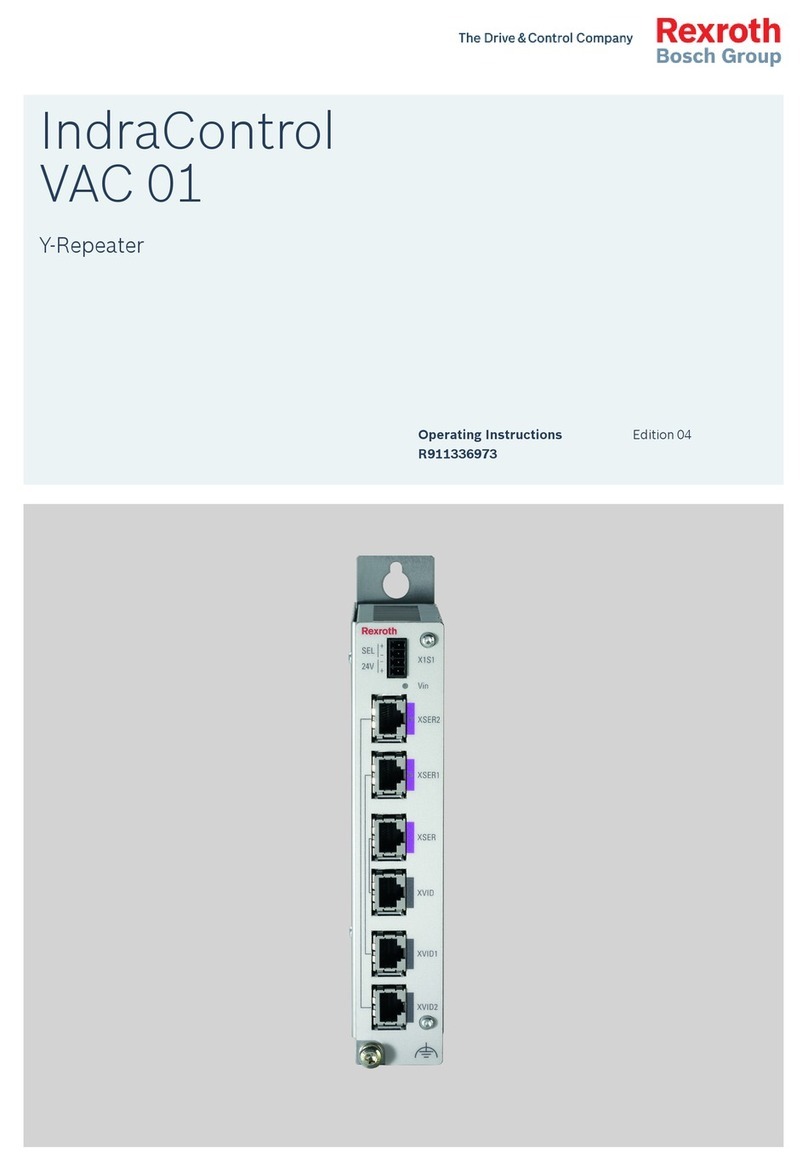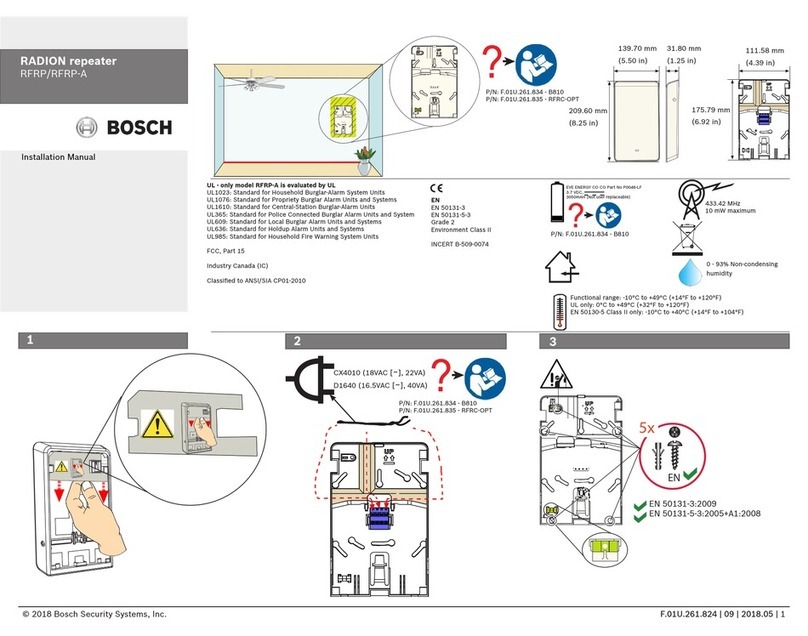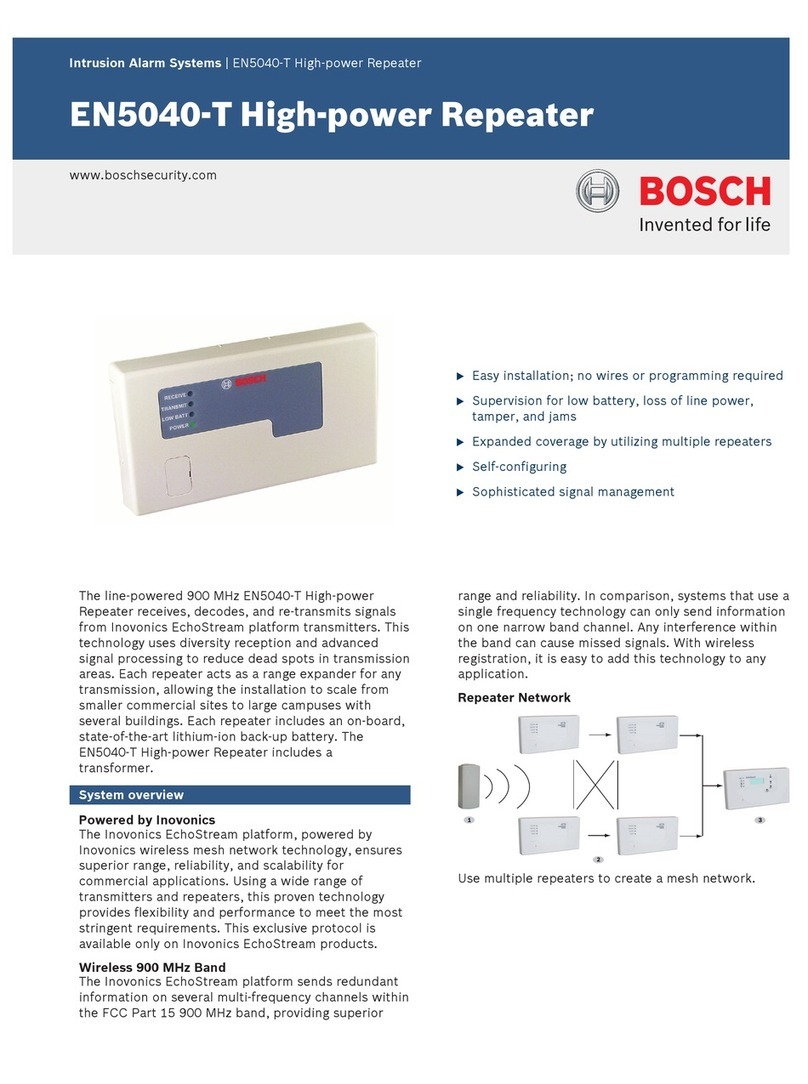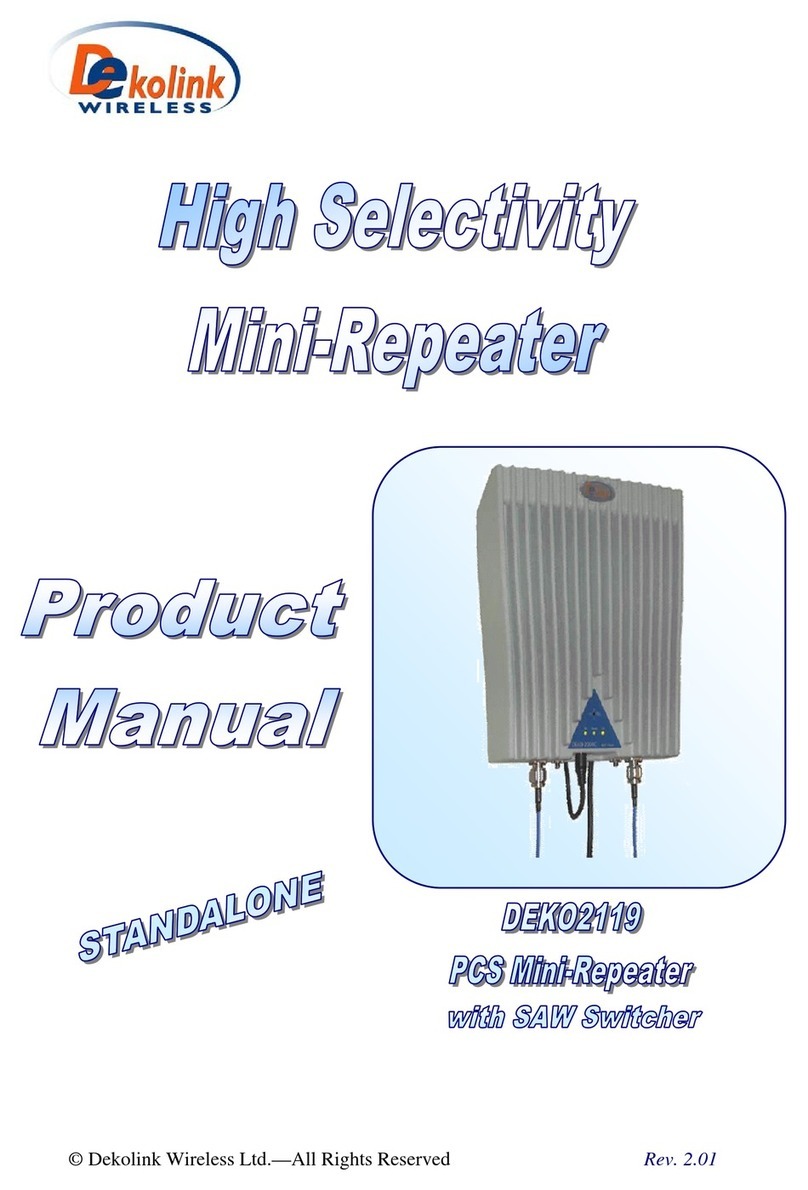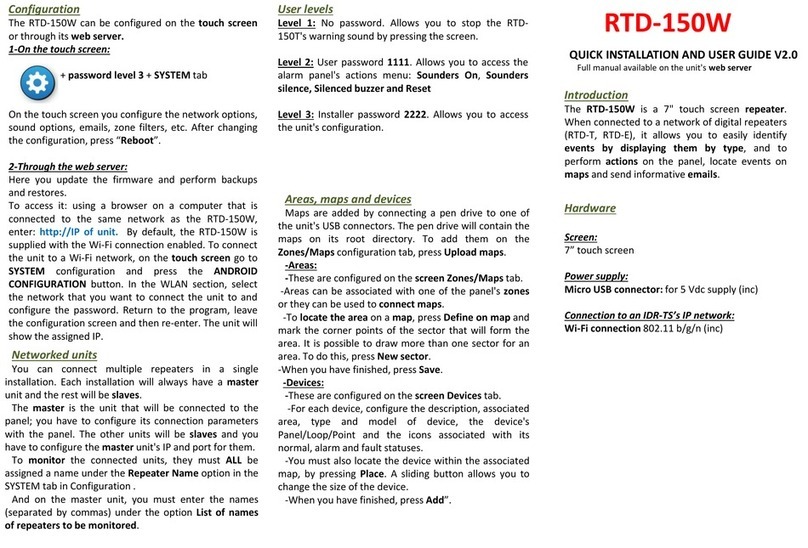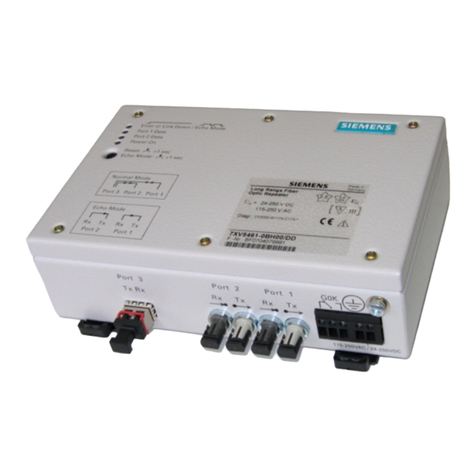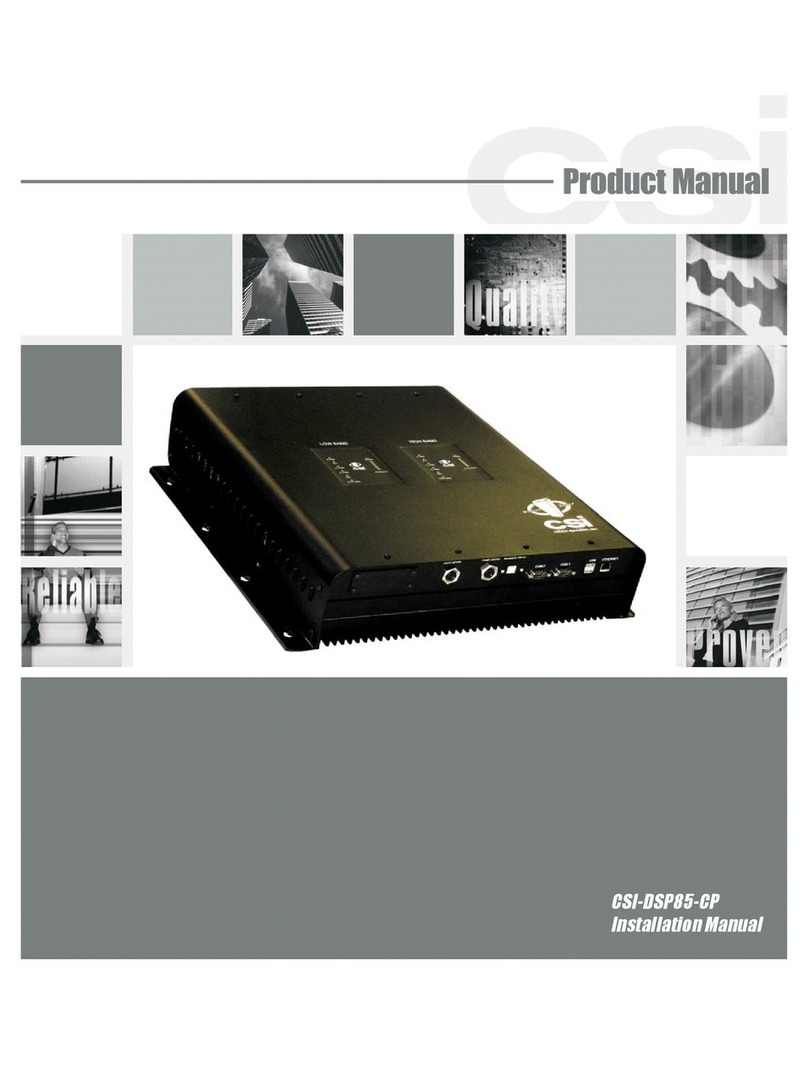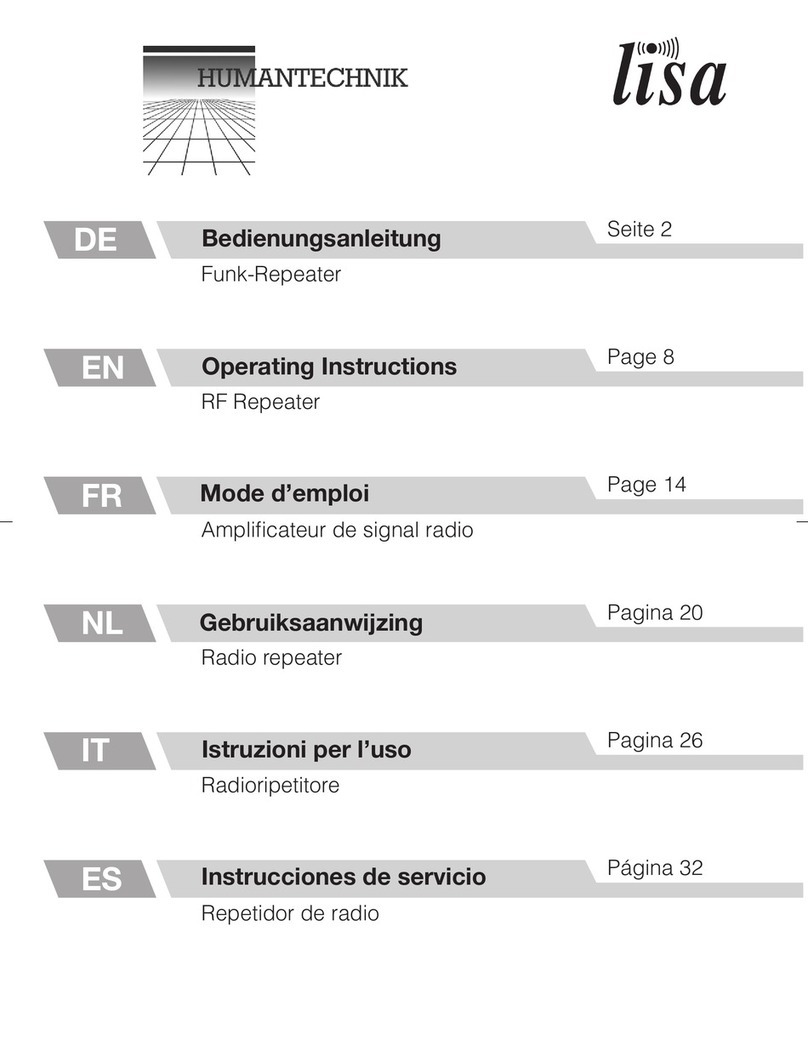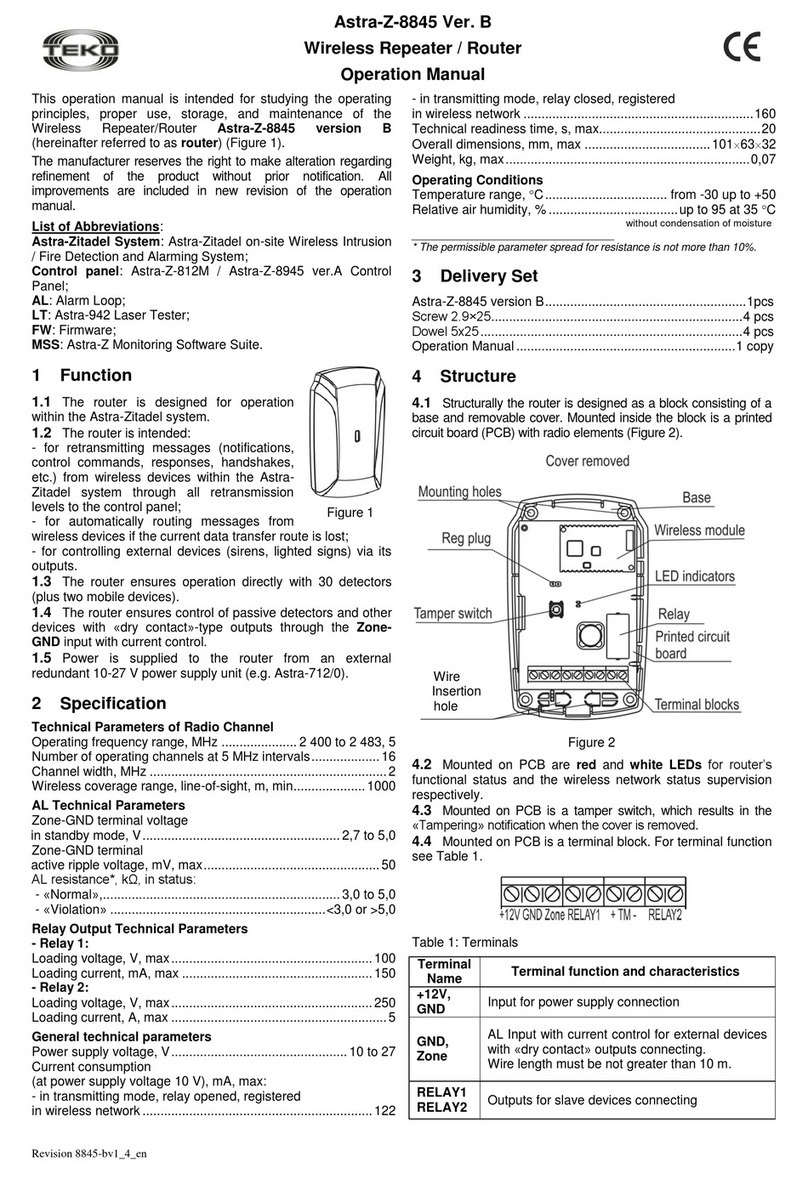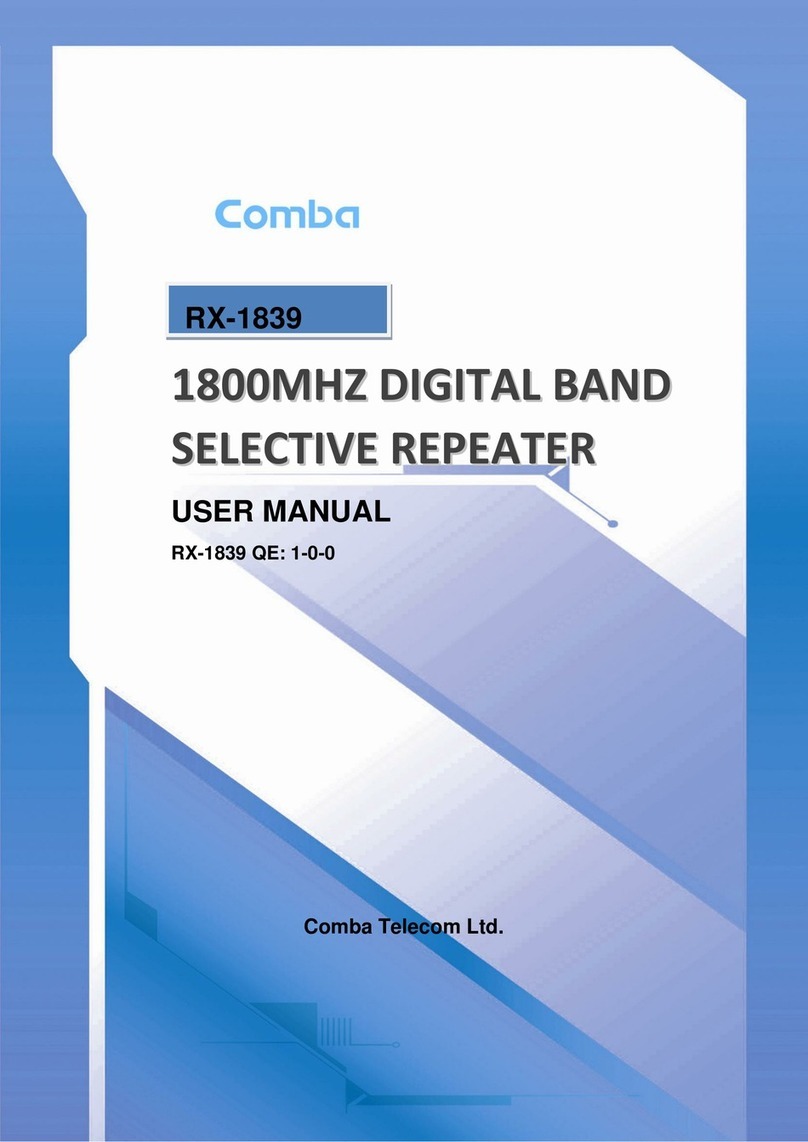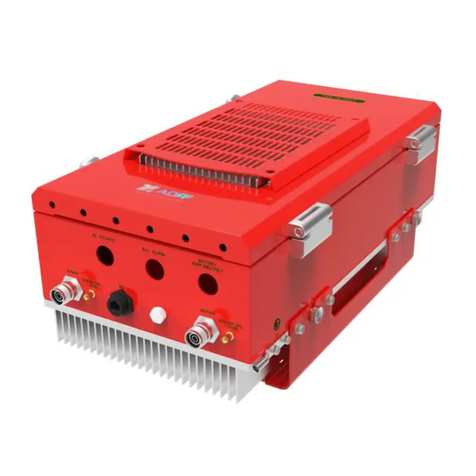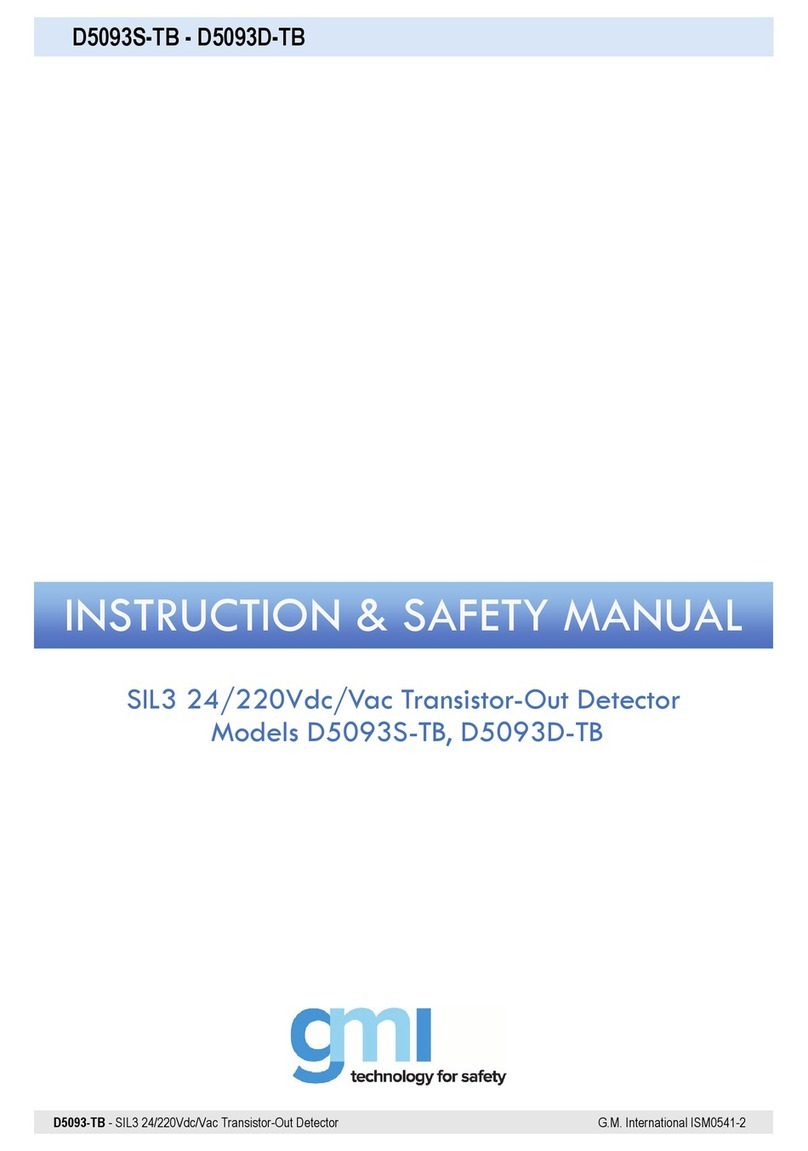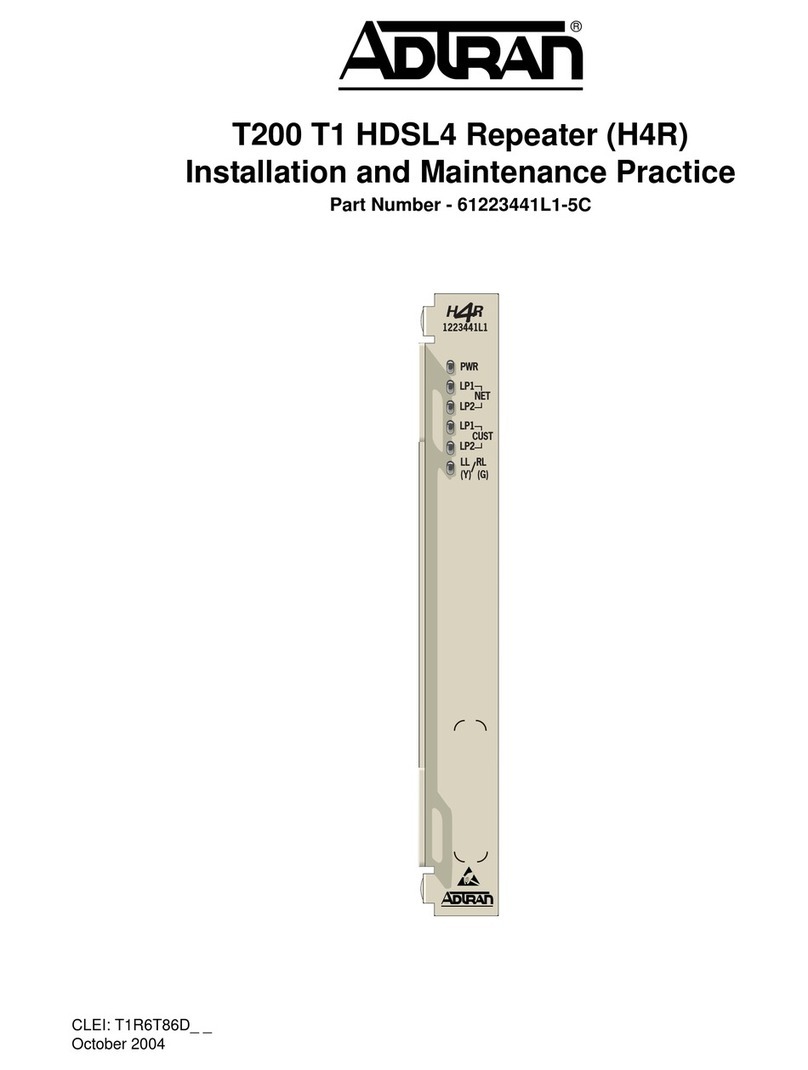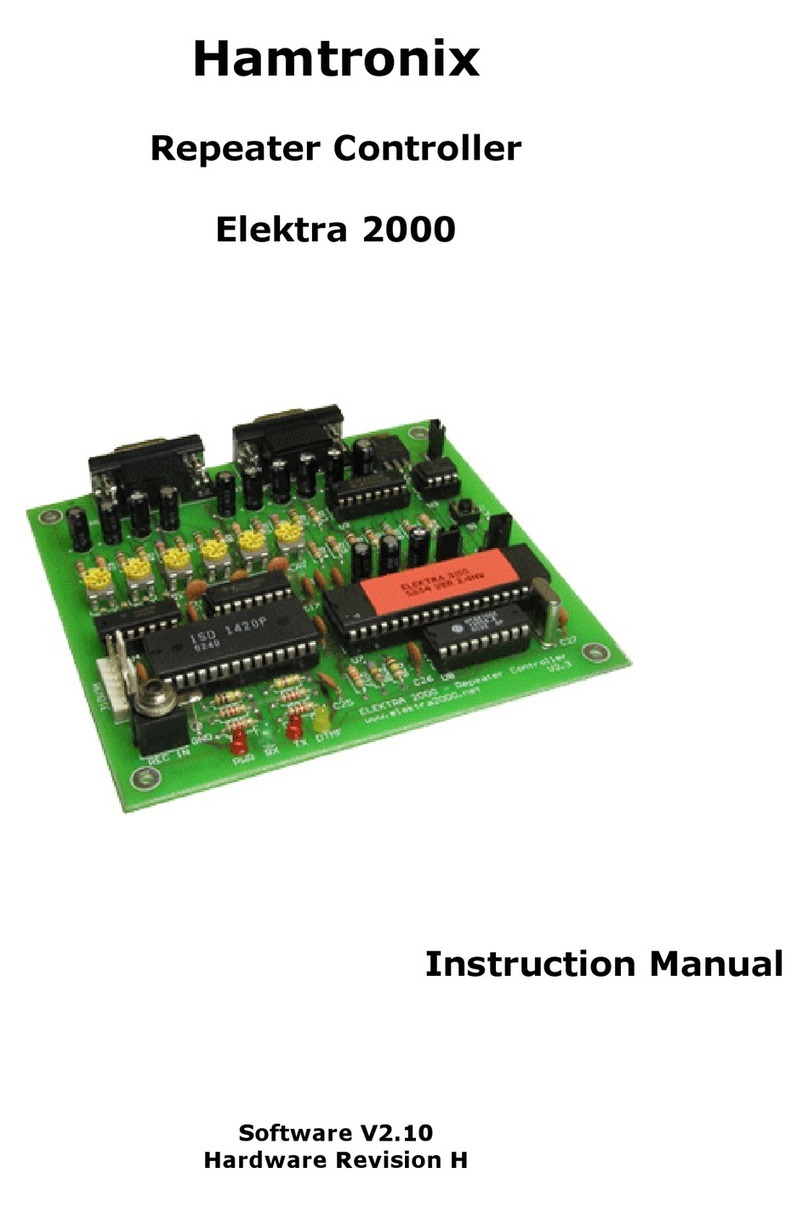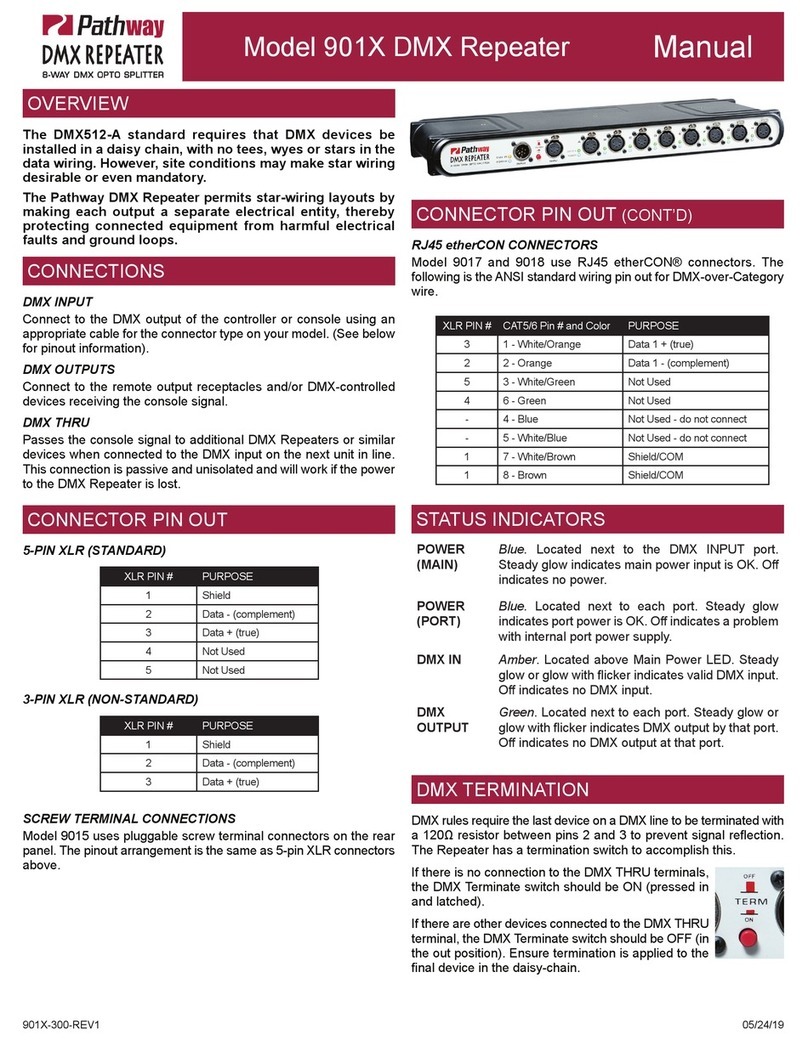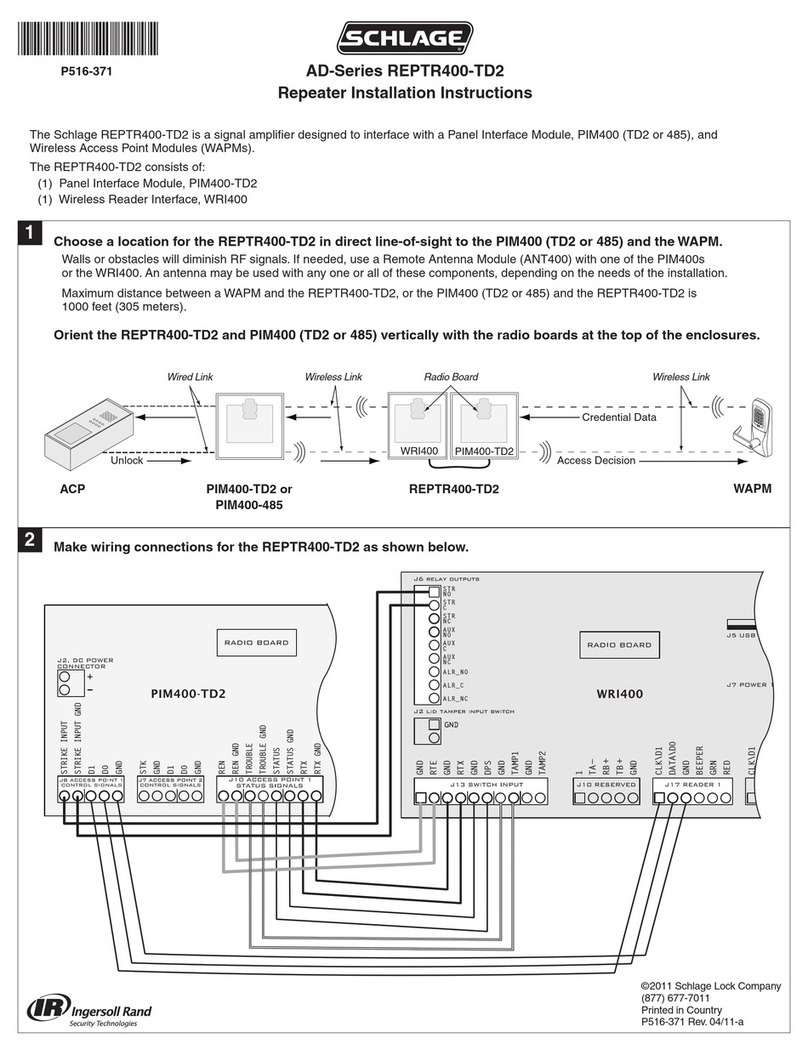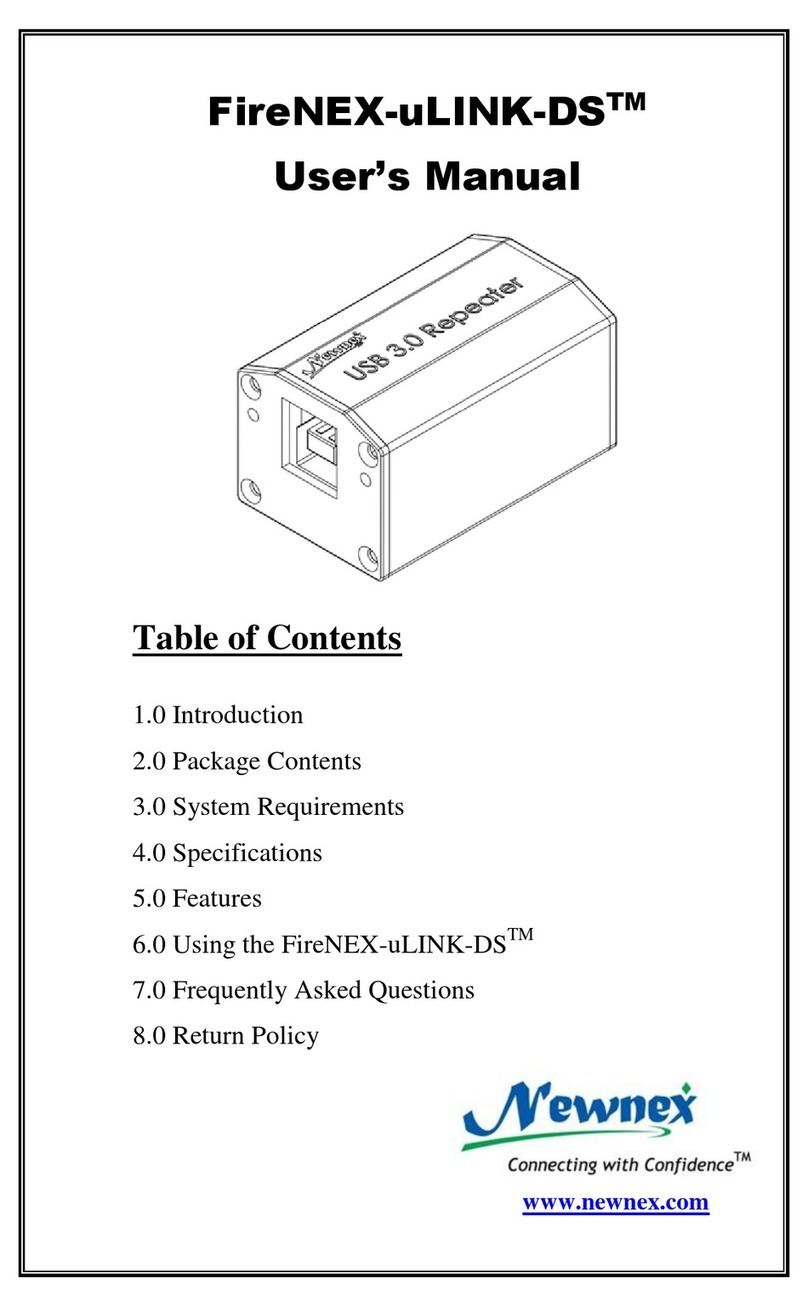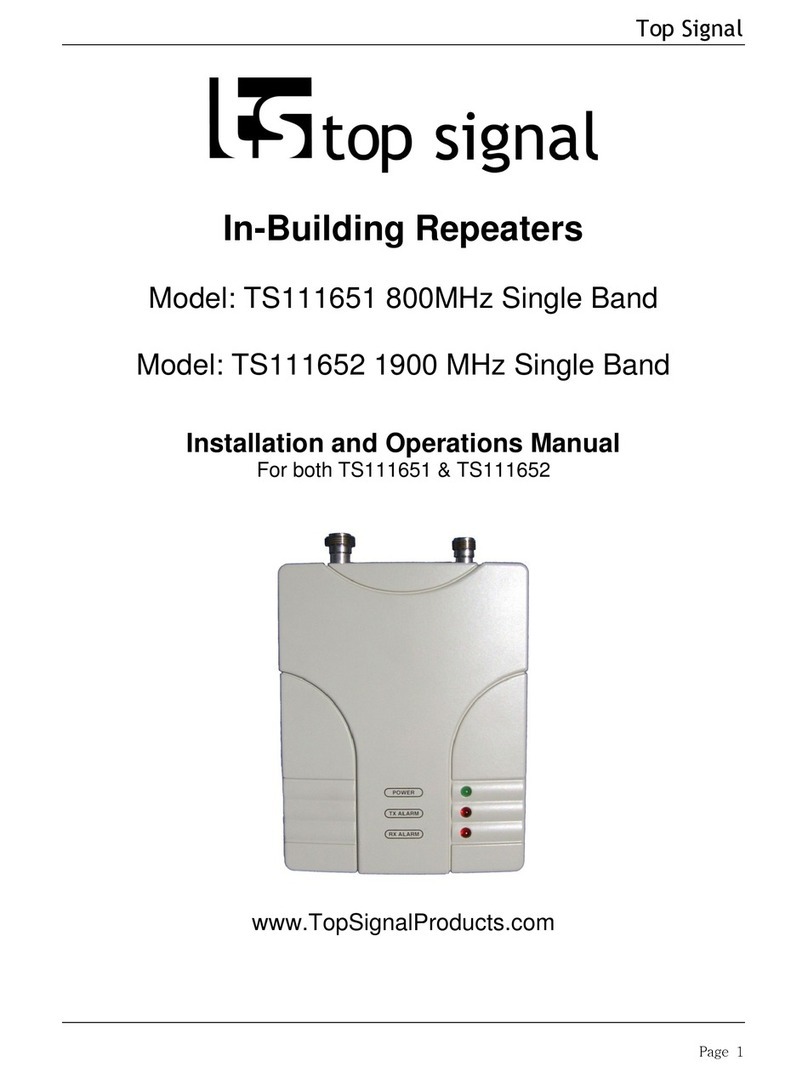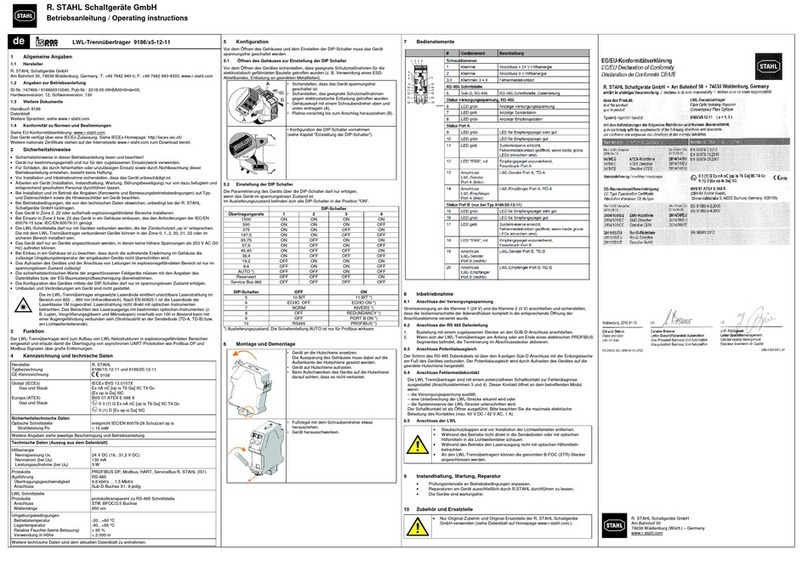Bosch Safecom SC720 Quick start guide

SAFECOM SC720/SC820 Data Repeater
Operation and Installation Guide

SC720/SC820 Operation and Installation Guide
90007-201C Page 2 © 2004 Bosch Security Systems
FCC Statement
Federal regulations require a station license for each radio installation be obtained by the equipment owner. The
licensee is responsible for ensuring transmitter power, frequency, and deviation are within the limits permitted by
the station license.
Transmitter adjustments may be performed only by a licensed technician holding an FCC first, second or general
class commercial radiotelephone operator’s license. There is no license required to install or operate the radio.
FCC ID: IVN 3470

SC720/SC820
Contents
SC720/SC820 Operation and Installation Guide
© 2004 Bosch Security Systems Page 3 90007-201C
1.0 Introduction.......................................................................................5
1.1 Manual Organization.........................................................................................................................................5
1.2 Documentation Conventions.............................................................................................................................5
1.2.1 Type Styles Used in this Manual ......................................................................................................................5
1.2.2 Tips, Important Notes, Cautions and Warnings................................................................................................5
1.3 Listings and Standards .....................................................................................................................................6
1.3.1 UL Listing ....................................................................................................................................................6
1.3.2 NFPA Standards...............................................................................................................................................6
2.0 Overview............................................................................................ 7
2.1 SAFECOM Overview........................................................................................................................................7
2.2 Data Repeater Communications.......................................................................................................................8
2.3 SC720/SC820 Data Repeater Overview ..........................................................................................................8
2.4 System Specifications.......................................................................................................................................9
2.4.1 General ....................................................................................................................................................9
2.4.2 Receiver ....................................................................................................................................................9
2.4.3 Transmit ....................................................................................................................................................9
3.0 Installation.......................................................................................10
3.1 Requirements..................................................................................................................................................10
3.1.1 Earth Ground ..................................................................................................................................................10
3.1.2 Wiring and Cable ............................................................................................................................................10
3.1.3 Power ..................................................................................................................................................10
3.1.4 Antenna Location............................................................................................................................................11
3.1.5 Surge Protection.............................................................................................................................................11
3.1.6 Data Repeater Location..................................................................................................................................11
3.2 Connecting Cables to the SC720/SC820 .......................................................................................................12
4.0 Operation.........................................................................................13
4.1 Controls and Indicators...................................................................................................................................13
4.2 Panel Control Settings for Data Repeater Communications...........................................................................15
4.3 Procedures ..................................................................................................................................................15
4.3.1 Transmit a Test Data Pattern..........................................................................................................................15
4.3.2 Audibly Monitor Only SAFECOM Messages ..................................................................................................15
4.3.3 Audibly Monitor all Radio Activity....................................................................................................................15
5.0 System Adjustments ......................................................................17
5.1 SC720/SC820 System Adjustments...............................................................................................................17
5.2 Removing/reinstalling the SC720/SC820 and DK1000 Access Covers .........................................................17
5.2.1 Removing the access covers..........................................................................................................................17
5.2.2 Reinstalling the access covers .......................................................................................................................17
5.3 Settings............................................................................................18
5.3.1 The Squelch Threshold...................................................................................................................................18
5.3.2 Setting the Modulation Deviation....................................................................................................................18
5.3.3 Setting the Hanging Time ...............................................................................................................................19
5.3.4 Output Power..................................................................................................................................................19
5.3.5 Setting the Decode Characters.......................................................................................................................19
5.4 Setup for an Addressable Data Repeater.......................................................................................................20
5.4.1 Setting the Address Codes.............................................................................................................................20
5.5 Summary of IP1 Header Pins.........................................................................................................................20
5.6 DK1000 Default Settings ................................................................................................................................21

SC720/SC820
Contents
SC720/SC820 Operation and Installation Guide
90007-201C Page 4 © 2004 Bosch Security Systems
Figures
Figure 1: Data Repeater Operations ......................................................................................................................................8
Figure 2: SC720/SC820 Rear Panel ....................................................................................................................................12
Figure 3: SC720/SC820 Front Panel....................................................................................................................................13
Figure 4: System Adjustments..............................................................................................................................................18
Tables
Table 1: SC720/SC820 Operation and Installation Guide Manual Organization....................................................................5
Table 2: UL Listings................................................................................................................................................................6
Table 3: NFPA Standards.......................................................................................................................................................6
Table 4: SC720/SC820 Rear Panel Connectors..................................................................................................................12
Table 5: SC720/SC820 Front Panel Items...........................................................................................................................14
Table 6: SC720/SC820 Decode Character = 3 for Primary SC720/SC820..........................................................................20
Table 7: SC720/SC820 Decode Character = 3 for Backup SC720/SC820..........................................................................20
Table 8: DK1000 Controller Board Pin Settings...................................................................................................................20
Table 9: IP1 Header Pins......................................................................................................................................................20
Table 10: DK1000 Default Settings ......................................................................................................................................21

SC720/SC820
Introduction
SC720/SC820 Operation and Installation Guide
© 2004 Bosch Security Systems Page 5 90007-201C
1.0 Introduction
1.1 Manual Organization
This manual is divided into 6 sections. A summary of each section and appendix is detailed in the table below.
Section Description
1 Introduction
2 Overview
3 Installation
4 Operation
5 System Adjustments
6 Troubleshooting
Table 1: SC720/SC820 Operation and Installation Guide Manual Organization
1.2 Documentation Conventions
These conventions are intended to call out important features, items, notes, cautions, and warnings that the
reader should be aware of in reading this document.
1.2.1 Type Styles Used in this Manual
To help identify important items in the text, the following type styles are used:
Bold text usually indicates selections that you may use while programming your panel. It may
also indicate an important fact that should be noted.
Bold Italicized
used to denote notes, cautions and/or warnings
Italicized text
Is used to reference the user to another part of this manual or another manual
entirely. It is also used to symbolize names for records that the user will create.
Courier Text Text that appears like this indicates what may appear on the D5200 Programmer
display, command center/keypad or internal printer.
[CAPITALIZED TEXT] Text like this is used to indicate to the user that a specific key should be pressed.
Example: …press the [ESC] key…
Italicized Text
Text that appears like this indicates what would be seen in the D5200 Programmer’s
Display. It is used as a section heading and screen example. Shaded boxes indicate
programmer prompts that are only available when Custom or View Events are
selected. (Used only in the Program Entry Guide documents).
1.2.2 Tips, Important Notes, Cautions and Warnings
Throughout this document, helpful tips, important notes, cautions and warnings will be presented for the reader
to keep in mind. These appear different from the rest of the text as follows:
Important Notes - should be heeded for successful operation and programming. Also tips and
shortcuts may be included here.
Caution - These caution the operator that physical damage to the program and/or equipment may
occur.
Warning - These warn of the possibility of physical damage to the operator, program and/or
equipment.

SC720/SC820
Introduction
SC720/SC820 Operation and Installation Guide
90007-201C Page 6 © 2004 Bosch Security Systems
1.3 Listings and Standards
1.3.1 UL Listing
The SAFECOM SC720/SC820 Data Repeater system is Listed by Underwriters Laboratories (UL) as follows:
Application and Category Listing
Standard
Central Station Burglar Alarm Units
•COMMERCIAL BURGLARY - AA” Rating UL 1610
Central Station “Police Connect” Mercantile
•“AA” Rating UL 365
Control Units for Fire Protective Signaling Systems
•“COMMERCIAL FIRE” Rating UL 864
Proprietary Burglar Alarm System Units
•PROPRIETARY BURGLARY - AA” Rating UL 1076
Household Burglar Alarm Units
•“RESIDENTIAL BURGLAR ALARM” Application UL 1023
Household Fire Warning System Units
•“RESIDENTIAL FIRE “ Application UL 985
Process Management Systems
•Service: “Non-Critical Applications” UL 864
Table 2: UL Listings
1.3.2 NFPA Standards
The SAFECOM SC720/SC820 Data Repeater system meets the following NFPA Standards:
Application Standard No.
Central Station Signaling Systems NFPA No. 71
Auxiliary Protective Signaling Systems NFPA No. 72B
Remote Station Protective Signaling Systems NFPA No. 72C
Proprietary Protective Signaling Systems NFPA No. 72D
Table 3: NFPA Standards
In accordance with NFPA No. 71 and UL Requirements the maximum number of subscriber control units
(SAFECOM Remote Communications Panels) that a single SAFECOM SC720/SC820 Data Repeater can
monitor for Fire and/or Burglary Applications is “512.”
If the number of subscriber control units exceeds 512, a second SC720/SC820 Data Repeater will be required to
monitor and control the additional units.
If the SAFECOM system is configured with more than one (1) SC720/SC820 Data Repeater, the number of
subscriber control units that can be monitored and controlled is UNLIMITED.

SC720/SC820
Overview
SC720/SC820 Operation and Installation Guide
© 2004 Bosch Security Systems Page 7 90007-201C
2.0 Overview
2.1 SAFECOM Overview
SAFECOM is a long-range telemetry communications system for monitoring remote security alarm panels which
are located at a customer site. The SAFECOM system utilizes specially designed telemetry transmitters and
receivers to provide a secure and reliable radio communications link between remote alarm control panels and a
Central Monitoring Station. The information provided to the Central Station allows security personnel or local
authorities to respond immediately and appropriately to all alarm events detected at the customer site.
The SAFECOM system is listed by Underwriters Laboratories (UL) as an
“AA”
rated security device for telemetry
reporting, RADIO as PRIMARY, of Burglary and Fire Alarm events and information.
The SC9000 Receiver acts as the nerve center of the SAFECOM System. The SC9000 Receiver uses the
SAFECOM ST1000 receiver software for system control and processing. The SC9000 communicates with
Remotes via the RF2000 Radio Modem. Selected system events are permanently recorded on a Micronics dot
matrix printer.
A Radio Communicator is a SAFECOM SC4000 Communications Panel which is located at a customer site;
commercial or residential. The Remote intercepts ALL of the Alarm Panel Digital Messages from the Digital
Alarm Communicator (DAC or DIALER), digitally encodes it, and performs a full data transfer via a RADIO
communications link to the Base Station’s SC9000 Receiver as the PRIMARY routing.
The digital data is processed by the SC9000 Receiver with a virtual instantaneous transfer of alarm information
to a Central Monitoring Station’s Automation software. Normal routing of the Digital Alarm Messages is via a
RADIO communications link between a Remote and the SC9000 Receiver; then to an Automation software via
an RS232 interface cable.
The SC9000 Receiver can supervise, monitor, and control up to 2,500 Remotes through two-way RADIO
telemetry communication in the redundant configuration. The receipt of each message or supervisory poll that is
transmitted, is validated by the receiving site. The receiving site will transmit an acknowledge message in
response.
Supervisory polling is performed by the SC9000 Receiver for each Remote to verify two-way RADIO telemetry
communications and the operational condition of the Remote. The polling interval is individually programmable
for each Remote. The SC9000 Receiver can monitor 240 unique Alarm Panel Event Codes from each Remote.
The Remote can also monitor the Normal/Open/Short status for four (4) Auxiliary Inputs. These input lines allow
End-Of-Line (EOL) supervisory loop status monitoring of four auxiliary devices. Any change of status to the
inputs is immediately reported to the SC9000 Receiver or routed to initiate fault follower behavior for the Auxiliary
Output relays. The box tamper switch is permanently connected to an auxiliary input line for continuous
monitoring of panel door open/closure status.
There are also four (4) 2-position contact relay controlled Auxiliary Outputs. The Base Station operator can
remotely control the On/Off status of an auxiliary device by sending RADIO commands, from the SC9000
Receiver, to Enable or Disable the output relays. The Remotes may also be programmed to automatically Enable
or Disable the output relays in response to an Auxiliary Input or Remote system Failure condition.
The SAFECOM system functions strictly in a supervisory capacity when interfaced with an existing alarm system.
The Remotes are intercept/delivery systems which are designed for easy installation and interface with an alarm
system; just connect the alarm panel telephone output cable to the Remote phone terminals. NO modifications to
the existing alarm system are required! The normal operation of the existing alarm panel and security system is
NOT affected in any way. The existing detectors and initiating circuits still report the status of items directly to the
alarm panel.
The RF2000 and Remotes are normally configured to transmit and receive (Tx/Rx) in the 450-470 MHz UHF
Radio Frequency (ElF) range. Additional frequency Ranges are available upon request. Nominal reception range
is dependent on the extent of environmental effects, i.e. propagation, and the proximity of the transmitter/receiver
to dense foliage and structures. The SC9000 radio Comm Port can drive a single RF channel or with the
installation of a SAFECOM 4 or 8 port Expander Board it can drive from 1 to 8 independent RF channels.
To ensure alarm events are reported by the Alarm Panel Dialer, when it seizes the communications line and
starts dialing the programmed phone number, all SAFECOM Remotes are configured with a FALLBACK feature.
In the event of a Remote RADIO, hardware, software, or total power failure the digital alarm messages are
automatically routed via a telephone communications line to a digital receiver; then to the Automation software
via an RS232 interface cable. This provides a life safety BACKUP communications link for routing of Alarm Panel
messages to the Central Monitoring Station.
The SAFECOM IT1500 Installation/Sales Tool tests for a standardized signal level, at the customer site, from the
RF2000 Radio Modem. Through this testing, by a Sales or Service Representative, the potential for valid two-
way RADIO communications can be confirmed for a Remote and the SC9000 Receiver prior to the installation of
a SAFECOM system.

SC720/SC820
Overview
SC720/SC820 Operation and Installation Guide
90007-201C Page 8 © 2004 Bosch Security Systems
2.2 Data Repeater Communications
A Data Repeater is a well situated automatic re-transmission station used to significantly extend the effective
RADIO communications range of a transceiver. The Data Repeater station consists of a receiver, control
circuitry, interconnect circuitry, a transmitter, power supplies, an optional duplexer and at least one antenna. The
SAFECOM Data Repeater is a FULL DUPLEX FM RADIO repeater. The repeater receives the RADIO signal on
one frequency, demodulates it, processes it, remodulates it, applies it to the input of the repeater transmitter, and
re-transmits it on a second frequency. A Full Duplex system can transmit and receive at the same time
(simultaneously).
2.3 SC720/SC820 Data Repeater Overview
The ability of the SC9000 Receiver to monitor Radio Communicator Panels, which are geographically separated
by great distances, is significantly improved by telemetry range extension through the use of the SAFECOM
SC720/SC820 Data Repeater.
Note: The SC720/SC820 is intended for single (one) customer operating company service.
The SAFECOM SC720/SC820 Data Repeater is a Full Duplex, real-time, digital data repeater system. It
simultaneously receives (FREQ X) and transmits (FREQ Y) on two separate RADIO frequencies, in the UHF
frequency spectrum. See Figure 1.
Base Station
AUTOMATION
SOFTWARE SC9000
RECEIVER
PRINTER
RF2000
SC4000
Customer Site
Repeater Site
SC820
FREQ Y
FREQ X
FREQ X
FREQ Y
Figure 1: Data Repeater Operations
The SC720/SC820 is based on a Kenwood model #TKR-820 platform. The existing repeater signaling unit has
been replaced by the SAFECOM DK1000 Controller Board. The incorporation of the DK1 000 provides the real-
time digital data repeater capability to the system.
Note: The SC720/SC820 can NOT be used as a transceiver for voice, voice repeater, or store and forward
digipeater communications.
The SC720/SC820 has an enhanced feature to limit identifying-carrier detect (CD) to SAFECOM RADIO signals
transmitted by the RF2000 Radio Modem or Remote comm panels. The DK1000 controller board will look at the
group of message bytes received when it detects a RADIO carrier (Carrier Detect - CD). If the CD message
groups do NOT contain the proper message validation, the RADIO signal will be ignored by the SC720/SC820.
ONLY messages with the proper validation byte messages will be processed by the DK1000 controller board for
data repeater RADIO communications.
The SC720/SC820 power output is adjustable from a minimum of 2 watts to a maximum of 25 watts. The
SC720/SC820 can be configured with a duplexer to allow the transmitter and receiver to connect to the same
antenna. With a duplexer installed, the maximum power output is reduced.

SC720/SC820
Overview
SC720/SC820 Operation and Installation Guide
© 2004 Bosch Security Systems Page 9 90007-201C
2.4 System Specifications
2.4.1 General
Frequency Range 450 to 470 MHz (others available)
Number of ElF Channels 1
ElF Channel Spacing 12.5 kHz
PLL Channel Step 12.5 kHz
Input Voltage 120/220 VAC, 50/60 Hz and/or
13.8 VDC Backup/Primary
Fuse 3 Amp for 120 VAC
1.6 Amp for 220 VAC
10 Amp for 13.8 VDC
Power Consumption 200 Watts Max
Duty Cycle 50% at 20 W output
100% at 5 W output
Temperature Range -22°F to +140°F
(-30°C to +60°C)
Dimensions (H x W x D) 4.7 in. x 13 in. x 15 in.
(120 mm x 330 mm x 383 mm)
Weight 29 lbs (13 kg) (without duplexer)
2.4.2 Receiver
RF Input Impedance 50 Ω
Sensitivity, EIA 12 dB SINAD 0.35 µV
Squelch Sensitivity 8 db SINAD
Modulation Acceptance ±5 kHz
Selectivity -80 dB
lntermodulation -75 dB
Spurious and Image Rejection -85 dB
Audio Power Output 4W at 4 Ωless than 5% distortion
Frequency Stability +0.00025% from -22°F to +140°F (-30°Cto +60°C)
2.4.3 Transmit Without Duplexer 2W to 25W
RF Power Output (adjustable) With Duplexer Installed 2W to 20W
RF Output Impedance 50 Ω
Spurious and Harmonics -70 dB
Direct FM Modulation +2.5 kHz for 100% at 1000 Hz
FM Noise -50 dB
Microphone Impedance Low Impedance (<1000 Ω)
Audio Distortion Less than 3% at 1000 Hz
Frequency Stability +0.00025% from -22°F to +140°F (-30°Cto +60°C)
Hang Time Variable 1-256 mS
Attack Time 3 or 5 bytes, 25 or 42 mS

SC720/SC820
Installation
SC720/SC820 Operation and Installation Guide
90007-201C Page 10 © 2004 Bosch Security Systems
3.0 Installation
ELECTRICAL HAZARD!! High Voltage (HV) and High Energy (HE) potential exists on uninsulated
components with the enclosure of the SC820. Service is restricted to authorized factory, or field site
personnel.
This equipment should ONLY be serviced by experienced technicians familiar with similar types of
commercial grade communications equipment.
The circuit fuse for the SC720/SC820 is located inside the unit. Disconnect system power prior to
servicing.
Electrical current from power and communications cables is hazardous. Connect and disconnect
cables as specified by the manufacturers recommendations when installing, moving, or opening the
covers of system components or attached devices.
All of the SAFECQM products, and attached devices, are equipped with a 3-wire power cord and
plug for the users safety. Use this power cord in conjunction with a properly grounded electrical
outlet to avoid electrical shock.
Do NOT transmit until all RF connectors are verified, secure, and any open connectors are properly
terminated.
Prior to the installation of the SC720/SC820 Data Repeater, several conditions must be satisfied and physical
phenomena considered to ensure personnel safety, compliance with UL requirements, and to optimize
performance capabilities of the SAFECOM system.
3.1 Requirements
3.1.1 Earth Ground
A proper Earth Ground SHALL be established and available for wiring to the electrical outlet used for the
SC720/SC820 AC power source. Utilize one or a combination of the following earth ground type connections:
1. Grounding rod. Use a dedicated 0.5 to 0.625 inch (1.3 to 1.6 cm) diameter copper clad metal rod; 6 to 10
feet (1.9 to 3 m) long. Attach the grounding wire to the rod utilizing a transition clamp made of an inert
material.
The proper transition clamp will help prevent galvanic corrosion due to two dissimilar materials in contact
with each other. The earth ground SHALL be installed pursuant to local soil conditions and in accordance
with building code requirements.
Note: An AC ground to the wiring conduit or electrical outlet may be used in conjunction with
the number 1 and 2 ground type connections.
2. Cold water pipe, metallic variety, routed to earth ground.
3. Site grounding halo.
3.1.2 Wiring and Cable
All wiring and coaxial cables utilized for the installation of the SC720/SC820 Data Repeater SHALL be in
accordance with proper RF engineering design and local building codes.
The following is recommended gauge and type wiring for installation of the SC720/SC820:
•AC Power - Connecting wires SHALL be at least 18 AWG; maximum length of 25 feet (7.6 m).
•EARTH GROUND line - In accordance with industry installation standards. Minimum 12 gauge solid wire.
•ANTENNA - The type of antenna feedline used for connecting the SC720/SC820 transmit and receive lines,
to an antenna(s), will be determined by the type of configuration used for each customer at a repeater site.
Select a feedline cable with as small a loss as possible, and its length should be as short as possible. The
VSWR of the antenna should be no more than 1.5 to 1.
Contact a Radionics SAFECOM Applications Engineer for assistance in making recommendations as to the type
of antenna feedline.
3.1.3 Power
Primary power for the SC720/SC820 Data Repeater is 120 VAC/60 Hz. Connect the SC720/SC820 to an
electrical outlet that is rated at 15 A.
For an UL Listed SC720/SC820 Data Repeater configuration, AC MUST be the Primary power source. One of
the following Backup power source configurations is required in the case of Primary AC power source FAILURE:

SC720/SC820
Installation
SC720/SC820 Operation and Installation Guide
© 2004 Bosch Security Systems Page 11 90007-201C
•If an auxiliary AC generator is installed at the repeater site, the DC backup source MUST be capable of
providing a 40 AH capacity over a period of four
(4)
hours.
•If NO auxiliary AC generator is installed at the repeater site, the DC backup source MUST be capable of
providing a 240 AH capacity over a period of twenty-four (24) hours.
Contact a Bosch SAFECOM Applications Engineer for DC power source requirements associated with the
following types of SC720/SC820 Data Repeater configurations:
•AC is NOT continuously available as the Primary power source.
•DC is the Primary power source.
•Transmitter is NOT set for maximum output power (less than 25 watts).
Note: Ensure the battery bank has sufficient AHr capacity to support all the repeater site equipment
connected to it.
3.1.4 Antenna Location
Numerous effects must be considered when determining the proper location for mounting the SC720/SC820
Data Repeater antennas. The proper antenna location is site specific for each installation. Contact a Bosch
SAFECOM Applications Engineer for recommendations to optimize transmission and reception of RADIO
signals.
3.1.5 Surge Protection
The SC720/SC820 Data Repeater has been tested with the following System Surge Protection Devices:
•AC Power Line Surge Suppressor: Poly Phaser #IS-PL-DO-120
•Antenna Lightning Surge Suppressor: Poly Phaser #IS-5OBN-C1-
MA
PoIy Phaser #NEMP-1
3.1.6 Data Repeater Location
The SC720/SC820 is designed to be installed in an electronics rack provided with a lock or against a vertical
surface using rack-mount brackets. The SC920 may also be installed on a flat horizontal surface resting on
rubber isolation pads inside a locked cabinet. The data repeater should be mounted to allow for easy access to
the connectors on the rear panel by a service technician.
The repeater stations shall be equipped with burglar alarm and automatic fire alarm systems connected to the
central station. The burglar alarm S7 item shall comply with the requirements designated in No. 3 in the
“Standard for Installation and Classification of Mercantile and Bank Burglar Alarm System,” UL 681.
Do NOT install the SC720/SC820 in a location subject to moisture, direct sunlight, or near heating equipment.
DO install the SC720/SC820 in a well ventilated location.
The SC720/SC820 is NOT environmentally sealed. Do NOT mount the SC720/SC820 Data Repeater in
a location exposed to the elements.

SC720/SC820
Installation
SC720/SC820 Operation and Installation Guide
90007-201C Page 12 © 2004 Bosch Security Systems
3.2 Connecting Cables to the SC720/SC820
The following connectors are located on the rear panel (See Figure 2).
TX RX
Figure 2: SC720/SC820 Rear Panel
Item Name Description
The Accessory connector is NOT currently utilized for Data Repeater operations.
Available for future expansion capability.
1 ACCESSORY
The ONLY item that should be connected to the Accessory
connector is the Senses supplied Molex plug. Otherwise,
equipment damage may occur.
2TX Connect the feedline cable which will be routed TO the transmitting antenna, the
XMTR input port of a duplexer, or the input to a transmitter combiner.
3RX Connect the feedline cable which will be routed FROM the receiving antenna,
the RCVR output port of a duplexer, or the output port of a receiving distribution
panel.
Connect the AC power cord to a 120 VAC/60 Hz grounded duplex electrical
outlet.
4 AC POWER
Ensure the power cord is secured to the duplex electrical outlet
utilizing a plug retaining clamp. This will prevent inadvertent
AC power loss due to accidental disconnection from the
electrical outlet.
5 DC POWER Connect the 12 VDC line from the DC power source.
Table 4: SC720/SC820 Rear Panel Connectors
This COMPLETES the installation procedures for the SC720/SC820 Data Repeater.

SC720/SC820
System Adjustments
SC720/SC820 Operation and Installation Guide
90007-201C Page 13 © 2004 Bosch Security Systems
4.0 Operation
4.1 Controls and Indicators
POWER
TAKE OVER
REPEAT
MONI
BUSY TX
VOLUME SQUELCH
POWER
ON
OFF
SC820
KENWOOD
Figure 3: SC720/SC820 Front Panel
The following is a description of the Controls and Indicators which are located on the front panel of the
SC720/SC820 Data Repeater (See Figure 3).
Item Name Description
1BUSY
Indicator Indicates the SC720/SC820 receiver is detecting radio carrier activity (Carrier
Detect - CD), on the RF channel, when the BUSY LED illuminates GREEN. This
is an indication that the SC720/SC820 is receiving some type of radio carrier
activity, NOT necessarily a SAFECOM transmission.
2MIC Microphone - Input receptacle for connecting an external microphone.
The MIC receptacle is NOT used for the data repeater communications. The
SC720/SC820 will NOT pass or transmit voice audio.
However, a microphone may be used as a TEST button to transmit a test data
pattern, high speed alternating tones, when the SC720/SC820 is NOT in the
repeat mode. The test data pattern may be used as a quick check to verify the
following:
•Modulation Deviation
•Transmitter Output Frequency
•Transmitter Output Power
•Antenna System SWR
•Functionality of the DK1000 Controller Board
See section 4.3.1 Transmit a Test Data Pattern for the procedure on how to
transmit a Test Data Pattern.
3MONI Monitor - The MONI button is NOT used for the data repeater communications.
The position of the MONI button does NOT affect SC720/SC820 Data Repeater
communications.
However, the Monitor function can be used to select audible monitoring, heard
from the internally mounted speaker, of SAFECOM ONLY (see section 4.3.2
Audibly Monitor Only SAFECOM Messages) radio messages or ALL
radio activity on the RF channel (see section 4.3.3 Audibly Monitor all Radio
Activity).

SC720/SC820
Installation
SC720/SC820 Operation and Installation Guide
90007-201C Page 14 © 2004 Bosch Security Systems
Item Name Description
4POWER Controls the ON/OFF condition for SC720/SC820 system power.
When the POWER button is in the recessed position (button IN) the
SC720/SC820 system power is ON and the POWER LED indicator will illuminate
RED.
When the POWER button is in the extended position (button OUT) the
SC720/SC820 system power is OFF and the POWER LED indicator is
extinguished.
5 REPEAT Enables the SC720/SC820 Data Repeater.
When the REPEAT button is in the recessed position (button IN) the
SC720/SC820 system is SET (ENABLED) for Data Repeater communications
with the SAFECOM system and the REPEAT LED indicator will illuminate
AMBER.
When the REPEAT button is in the extended position (button OUT) the
SC720/SC820 is INHIBITED (DISABLED) from data repeater communications
and the REPEAT LED indicator is extinguished.
6SQUELCHAllows manual adjustment of the noise squelch sensitivity to mute or unmute ALL
received audible RF activity heard from the internal SPEAKER.
Turn the Squelch knob CLOCKWISE to DECREASE the squelch sensitivity and
set the noise threshold level.’
Turn the Squelch knob COUNTER-CLOCKWISE to INCREASE the squelch
sensitivity and set the noise threshold level.
Note: The position of the Squelch knob does NOT affect
SC720/SC820 Data Repeater communications.
7 TAKEOVER Selects the interface capability (Enabled/Disabled) of the Accessory connector,
located on the rear of the SC720/SC820 Data Repeater unit.
When the TAKEOVER button is in the recessed position (button IN) the
Accessory connector is DISABLED and the TAKEOVER LED indicator will
illuminate AMBER. The SC720/SC820 system can NOT interface with other
SAFECOM Data Repeaters via the Accessory connector.
When the TAKEOVER button is in the extended position (button OUT) the
Accessory connector is ENABLED and the TAKEOVER LED indicator is
extinguished. The SC720/SC820 system CAN interface with other SAFECOM
Data Repeaters via the Accessory connector.
Note: The position of the Takeover button does NOT affect
SC720/SC820 Data Repeater communications when configured
as a single data repeater in a SAFECOM repeater network.
8TX Indicates the SC720/SC820 transmitter is transmitting an RF carrier signal when
the TX LED illuminates RED.
9VOLUME Controls the audible volume level of the radio activity on the RF channel activity
heard from the internally mounted speaker.
Turn the Volume knob CLOCKWISE to INCREASE the volume level, and
COUNTER-CLOCKWISE to DECREASE the volume level.
Note: The Volume knob does NOT affect SC720/SC820 Data
Repeater communications.
Table 5: SC720/SC820 Front Panel Items

SC720/SC820
Installation
SC720/SC820 Operation and Installation Guide
© 2004 Bosch Security Systems Page 15 90007-201C
4.2 Panel Control Settings for Data Repeater Communications
Set the following control function settings, as specified, for normal SC720/SC820 Data Repeater
communications:
1. MIC - Ensure NO microphone is installed in the input receptacle.
2. MONT - Position and Indications do NOT affect data repeater communications.
3. POWER - Set to ON. Button in recessed position (button IN); Indicator RED.
4. REPEAT - Set for Data Repeater communications. Button in recessed position (button IN); Indicator
AMBER.
5. SQUELCH - Position and Indications do NOT affect SC720/SC820 Data Repeater communications.
6. TAKEOVER - Set for Data Repeater operations. Button in extended position (button OUT); Indicator OFF.
7. VOLUME - Position does NOT affect SC720/SC820 Data Repeater communications
Note: Most Radio Site Managers require that the service speaker volume be turned down all the way, and/or
disabled, to reduce the ambient noise at the repeater site.
4.3 Procedures
4.3.1 Transmit a Test Data Pattern
1. Place the REPEAT button in the extended position (button OUT and LED is OFF).
2. Depress the Push-To-Talk (PU) switch on the microphone. The test pattern is ONLY transmitted while the
MIC PTT switch is depressed.
Data repeater communications are INHIBITED when the PiT switch is depressed. Ensure the MIC is
removed from the microphone input receptacle and the REPEAT button is in the recessed position
(button IN and LED illuminates AMBER) during normal data repeater communications.
4.3.2 Audibly Monitor Only SAFECOM Messages
1. Plug a MIC in the microphone input receptacle.
2. Place the MIC in the repeater Hang-Up Clip or hold the MIC button to a common radio chassis ground.
3. Place the MONI button in the extended position (button OUT and LED OFF).
The audio heard from the speaker is SAFECOM ONLY radio messages on the repeater RF channel.
4.3.3 Audibly Monitor all Radio Activity
•Remove the MIC from the microphone input receptacle.
OR
•Remove the MIC from the repeater Hang-Up Clip or the common radio chassis ground.
OR
•Place the MONI button in the recessed position (button IN and LED illuminates GREEN).
The audio heard from the speaker is ALL radio activity on the repeater’s RF channel.

SC720/SC820
Installation
SC720/SC820 Operation and Installation Guide
90007-201C Page 16 © 2004 Bosch Security Systems
Notes:

SC720/SC820
System Adjustments
SC720/SC820 Operation and Installation Guide
90007-201C Page 17 © 2004 Bosch Security Systems
5.0 System Adjustments
5.1 SC720/SC820 System Adjustments
This chapter discusses the procedures to make adjustments, verify operating values, or change the default
settings to the following items for the SAFECOM SC720/SC820 Data Repeater:
•Squelch Threshold
•Modulation Deviation
•Hang Time
•Output Power
•Decode Characters (Attack Time)
•Address Code
If any changes are made to items 1 thin 4 above, Senses International recommends that all four items (1 thin 4)
be checked to ensure proper operation of the SC720/SC820 Data Repeater.
5.2 Removing/reinstalling the SC720/SC820 and DK1000 Access Covers
ELECTRICAL HAZARD!! High Voltage (HV) and High Energy (HE) potential exists on un-insulated
components with the enclosure of the SC720/SC820. Service is restricted to authorized factory, or
field site personnel.
This equipment should ONLY be serviced by experienced technicians familiar with similar types of
commercial grade communications equipment.
The circuit fuse for the SC720/SC820 is located inside the unit. Disconnect system power prior to
servicing.
Electrical current from power and communications cables is hazardous. Connect and disconnect
cables as specified by the manufacturers recommendations when installing, moving, or opening the
covers of system components or attached devices.
All of the SAFECOM products, and attached devices, are equipped with a 3-wire power cord and
plug for the user’s safety. Use this power cord in conjunction with a properly grounded electrical
outlet to avoid electrical shock.
Do NOT transmit until all RF connectors are verified, secure, and any open connectors are properly
terminated.
5.2.1 Removing the access covers
Utilize the following procedures to REMOVE the SC720/SC820 and DK1000 access covers:
1. System Power OFF. Unplug the AC power cord from the electrical outlet or disconnect the DC power
source.
2. Remove the 6 retaining screws holding the upper portion of the SC720/SC820 unit cover.
3. Remove the upper portion of the SC720/SC820 unit cover.
4. Remove the 13 retaining screws holding the access cover, gold in color, to the DK1000 controller board.
5. Remove the DK1000 access cover.
5.2.2 Reinstalling the access covers
Utilize the following procedures to INSTALL the SC720/SC820 and DK1000 access covers:
1. System Power OFF. Unplug the AC power cord from the electrical outlet or disconnect the DC power
source.
2. Place the DK1000 access cover in position for installing the retaining screws.
3. Install the 13 retaining screws for the DK1000 controller board access cover.
4. Place the upper portion of the SC720/SC820 unit cover in position for installing the retaining screws.
5. Install the 6 retaining screws for the SC720/SC820 unit cover.

SC720/SC820
System Adjustments
SC720/SC820 Operation and Installation Guide
90007-201C Page 18 © 2004 Bosch Security Systems
5.3 Settings
5.3.1 The Squelch Threshold
Squelch Threshold is the sensitivity of the receiver to RADIO carrier. The Squelch is set by Bosch, at the factory,
to 8 db SINAD.
1
2
3
4
5
6
7
8JP1
TP1
TP5
1
1
1
CN2
CN1
CN3
R11
HANG
FRONT
SQU MOD
R10 R35
CD
LED
MODE
LED TP3
TP4
1JP2
VR1
RF AMPLIFIER
CPU
Figure 4: System Adjustments
1. System Power ON. When the shorting plug IS Installed on pin group #8 (DK1 000 UP 1 header), for normal
data repeater communications, the MODE LED will illuminate a BLINKING GREEN.
This provides a visual indication that the DK1000 Squelch and Hang Time adjustment controls are
LOCKED and ONLY SAFPCOM messages will activate the SC720/SC820 for Data Repeater
communications.
Any time that the shorting plug is removed from pin group #8, on the DK1000 JP1 header, the MODE LED
will illuminate a BLINKING RED. This provides a visual indication that the DK1000 Squelch and Hang Time
adjustment controls are UNLOCKED.
2. Remove the shorting pIug from pin group #8 on the DK1000 JP1 header and place it on pin group #7
(DK1000 JPI header). The MODE LED will change to a BLINKING RED illumination.
The HANG (R11) and Squelch (SQU – R10) adjustment controls are NOW UNLOCKED and the DK1000
Controller Board is in the Squelch Repeat Mode for receiver tuning. The Squelch Repeat Mode allows ANY
RF signal to activate the SC720/SC820; NOT just SATECOM messages.
3. Connect a RF Signal Generator to the receiver (RX) input, located on the rear panel of the SC720/SC820
Data Repeater.
•Set the output, of the RF Signal Generator, to the SC720/SC820 radio receiver frequency.
•Ensure the Squelch knob, on the front panel, is set FULL CCW.
•Take the SINAD reading from Pin #12 or #15 on the accessory Jack located on the rear panel.
•Inject an RF carrier signal at 8 db SINAD.
4. Adjust the Squelch pot (SQU – R10), on the DK1000, to a point where the Proper selling of the Squelch pot
will illuminate the RED CD (carrier detect) LED is just staying On (illuminating RED).
Proper setting of the Squelch pot will illuminate the RED CD LED at and above 8 db SINAD.
5.3.2 Setting the Modulation Deviation
Modulation Deviation is the amount of carrier frequency swing caused by the modulating signal. The Modulation
Deviation is normally set by Bosch, at the factory, to +2.0 KHz for Narrowband SAFECOM radios. Bosch can
also set the Modulation Deviation to +3.0 kHz for special configuration export versions of the SAFECOM radio.

SC720/SC820
System Adjustments
SC720/SC820 Operation and Installation Guide
© 2004 Bosch Security Systems Page 19 90007-201C
1. Connect a RF Signal Monitor to the transmit (TX) output, located on the rear panel of the SC720/SC820.
•Set the input of the RF signal Monitor to the SC720/SC820 radio transmitter frequency.
Note: If the RF Signal Monitor is NOT capable of dissipating 25 watts of transmitted energy,
terminate the SC720/SC820 TX output with a 50
Ω
terminator.
2. Move the shorting plug from pin group #7, on the DK1000 JP1 header, to pin group #7 on the DK1000 JP1
header to pin group #6 on the DK1000 JP1 header. The MODE LED will continue a BLINKING RED
illumination and the TX LED on the front panel will illuminate RED.
The SC720/SC820 is NOW transmitting a continuous data pattern.
3. Set continuous test data level deviation to +1.5 KHz by adjusting the Modulation pot (MOD - R35), on the
DK1000 controller board; ±3.0 KHz for certain export models.
4. Remove the shorting plug from pin group #6 on the DK1000 JP1 header.
5.3.3 Setting the Hanging Time
Hang Time is the amount of time that the transmitter will remain on after loss of the receive signal. The Hang
Time is set by Bosch, at the factory, so that the transmitter won’t dropout between a poll and acknowledge (ACK)
message from the SC9000 Receiver and a Remote communications panel to shorten the total message transmit
time.
1. Preset the Hang pot (HANG – R11) on the DK1000 controller board to the center of its rotation range.
2. Initiate transmit (TX) with the SAFECOM lT500 Installation Tool. If an IT1500 is NOT available, SAFECOM
communications data will suffice; i.e. polling and ACK messages.
The SC720/SC820 MUST be receiving and transmitting SAFECOM RADIO data (Poll and ACK messages)
for proper setting of the Hang Time. Final selling of the Hang Time can ONLY be performed after
SAFECOM system installation.
3. Observe the RED CD LED as it cycles ON and OFF a response to each data transfer from the
IT500/SC9000 or the SC4000/SC9000. The RED CD LED will either illuminate STEADY and then
extinguish OR it will DOUBLE-BLINK ON-OFF-ON-OFF at a very fast rate.
•If the CD LED illuminates STEADY: Slowly back off the HANG pot (R11) in the COUNTER-
CLOCKWISE direction until the RED CD LED starts the fast double-blink illumination.
Then increase the HANG pot (R11) rotation slightly in the CLOCKWISE direction; approximately 15°
(degrees) of rotation. The RED CD LED should NOT double-blink.
•If the RED CD LED is illuminating in DOUBLE-BLINK: Slowly increase the HANG pot (R11) rotation in
the CLOCKWISE direction until the RED CD LED illuminates STEADY for each data transfer.
Then Slowly increase the HANG pot (R11) rotation slightly more in the CLOCKWISE direction;
approximately 150°(degrees) of rotation.
This COMPLETES the setup procedures for the Squelch Threshold, Modulation Deviation and Hang Time.
INSTALL a shorting plug on pin group #8 (JP1 header) at the completion of DK1000 adjustments.
When the shorting plug is installed on pin group #8 (DK1000 JP1 header), for normal SC720/SC820 Data
Repeater communications, the MODE LED will illuminate a BLINKING GREEN.
5.3.4 Output Power
The SC720/SC820 RF Amplifier Output Power is adjustable from a minimum of 2 watts to a maximum of 25
watts. The SC720/SC820 can be configured with a duplexer to allow the transmitter and receiver to connect to
the same antenna. With a duplexer installed, the maximum power output is reduced.
1. Connect an UHF Watt Meter to the transmit (TX) output, located on the rear panel of the SC720/SC820.
2. Adjust VR1 (variable resistor #1), on the RF Amplifier, with a tuning tool for the desired Output power. VR1
is located just to the rear of the DK1000 Controller Board.
5.3.5 Setting the Decode Characters
Decode Characters specify the amount of Leading characters the SC720/SC820 must see before activating the
data repeater function. Decode Characters are contained in every packetized message group from an RF2000 or
SC4000.
The Decode Characters are set to three (3) by Bosch, at the factory. Three characters are SET when NO
shorting plug is installed on pin group #5, JP1 header on the DK1000 Controller Board.

SC720/SC820
System Adjustments
SC720/SC820 Operation and Installation Guide
90007-201C Page 20 © 2004 Bosch Security Systems
The Decode Characters are NORMALLY set to 3 for single SC720/SC820 Data Repeater communications.
However, the SAFECOM system can be configured with a second a hot-standby/backup system capability. The
Decode Character for the backup SC720/SC820 should be set to 5.
On the JP1 header, DK1000 Controller Board, INSTALL a shorting plug on pin group #5, for 5 characters. In this
configuration, an RF2000 or SC4000 will communicate with the 3 character configured SC720/SC820 as
Primary. If the 3 character configured SC720/SC820 (Primary) fails, the 5 character SC720/SC820 (Backup) will
assume the capability for Primary data repeater communications.
The following tables specify SC9000 Framer requirements, for radio timing parameters, when configured for
Backup SC720/SC820 Data Repeater communications.
Local Initiate Leading 9 chars Remote Initiate Leading 11 chars
Local ACK Leading 7 chars Remote ACK Leading 9 chars
Table 6: SC720/SC820 Decode Character = 3 for Primary SC720/SC820
Local Initiate Leading 11 chars Remote Initiate Leading 11 chars
Local ACK Leading 9 chars Remote ACK Leading 9 chars
Table 7: SC720/SC820 Decode Character = 3 for Backup SC720/SC820
5.4 Setup for an Addressable Data Repeater
The SC720/SC820 can be configured to a operate as an Addressable Data Repeater when multiple
SC720/SC820s are operating on the SAME radio communications frequency. When the Addressable Data
Repeater feature is Enabled, the SC720/SC820 will ONLY be activated for repeater communications in response
to messages from an RF2000 which is operating on the same RADIO communications frequency and has the
same Address Code. A unique Address Code is assigned by the SCS000 receiver for each RF channel (1 to 8).
Each RF channel communicates with the SC720/SC820 via an RF2000 radio modem.
The SC720/SC820 is ENABLED for Addressable Data Repeater communications when a shorting plug is
INSTALLED on pin group #4, JP1 header, on the DK1000 Controller Board.
To DISABLE the SC720/SC820 for Addressable Data Repeater communications, REMOVE the shorting plug
from pin group #4, JP1 header, on the DK1000 Controller Board.
When the SC720/SC820 is Disabled for Addressable Data Repeater communications, ALL SAFECOM
messages from an RF2000 operating on the same radio communications frequency, regardless of the RF
channel number, will activate the SC720/SC820.
5.4.1 Setting the Address Codes
To set the Address Codes for SC720/SC820 Data Repeater communications with a specific SC9000 channel
number, SC9000 Channel Number (1-8)
Pin Group # 1 2 3 4 5 6 7 8
3 OFF OFF OFF OFF ON ON ON ON
2 OFF OFF ON ON OFF OFF ON ON
1 OFF ON OFF ON OFF ON OFF ON
configure the
shorting plugs
on the JP1
header, DK1000
Controller
Board, as
follows: Table 8: DK1000 Controller Board Pin Settings
5.5 Summary of IP1 Header Pins
The following is a functional summary of the eight (8) pin groups located on the DK1000 JP1 header:
Pin Group # Function Pin
Group # Function
11of 3 Address Codes to specify the
RF Channel Number 5 Specifies 3 or 5 Character Message
Leading Requirements
2 2 of 3 Address Codes to specify the
RF Channel Number 6 Enable or Disable the Transmit of the Test
Data Pattern
3 3 of 3 Address Codes to specify the
RF Channel Number 7 Enable or Disable the Squelch Repeat
Mode
4Enable or Disable the Addressable
Repeater Feature 8Enable or Disable Normal SC720/SC820
Data Repeater Comms
Table 9: IP1 Header Pins
This manual suits for next models
1
Table of contents
Other Bosch Repeater manuals
